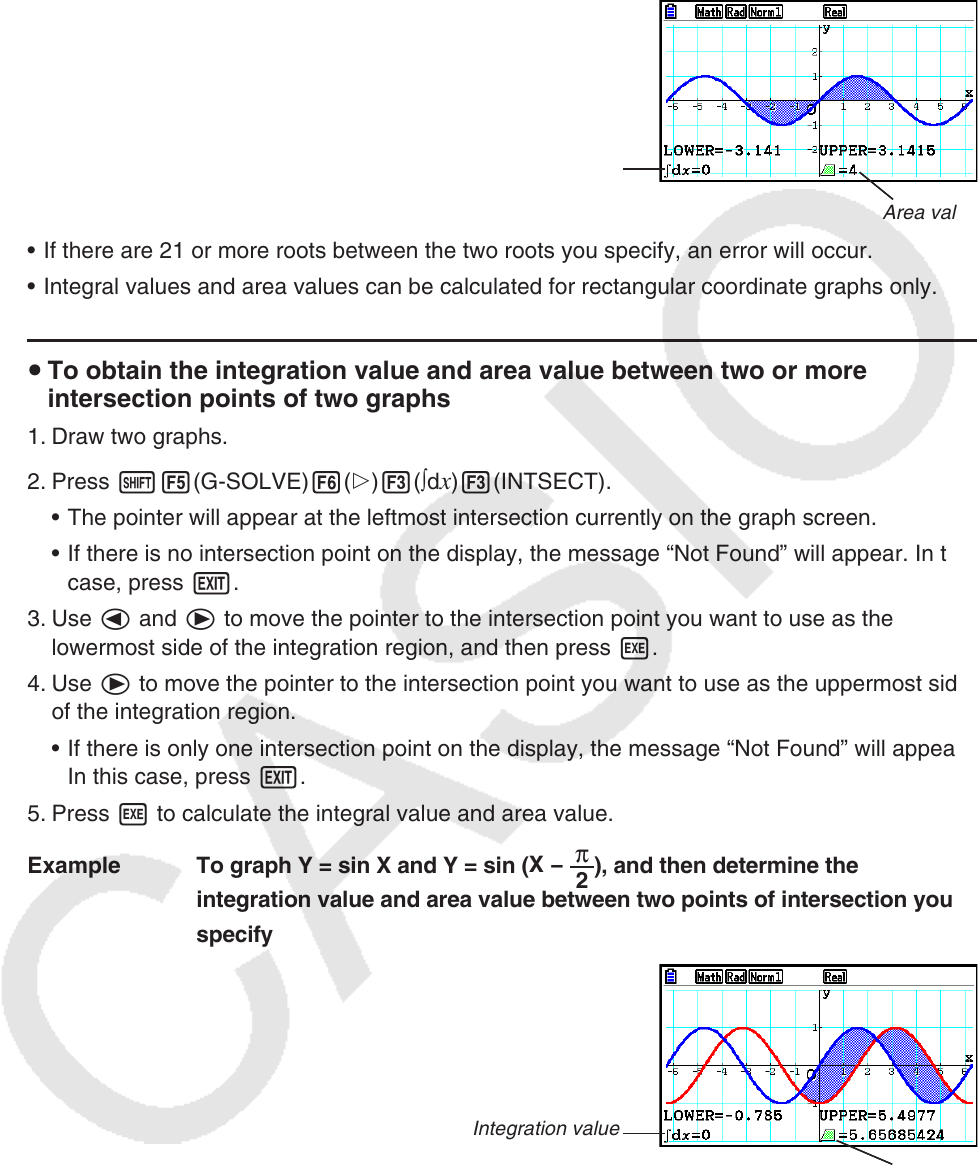User Manual
Table Of Contents
- Contents
- Getting Acquainted — Read This First!
- Chapter 1 Basic Operation
- Chapter 2 Manual Calculations
- 1. Basic Calculations
- 2. Special Functions
- 3. Specifying the Angle Unit and Display Format
- 4. Function Calculations
- 5. Numerical Calculations
- 6. Complex Number Calculations
- 7. Binary, Octal, Decimal, and Hexadecimal Calculations with Integers
- 8. Matrix Calculations
- 9. Vector Calculations
- 10. Metric Conversion Calculations
- Chapter 3 List Function
- Chapter 4 Equation Calculations
- Chapter 5 Graphing
- 1. Sample Graphs
- 2. Controlling What Appears on a Graph Screen
- 3. Drawing a Graph
- 4. Saving and Recalling Graph Screen Contents
- 5. Drawing Two Graphs on the Same Screen
- 6. Manual Graphing
- 7. Using Tables
- 8. Modifying a Graph
- 9. Dynamic Graphing
- 10. Graphing a Recursion Formula
- 11. Graphing a Conic Section
- 12. Drawing Dots, Lines, and Text on the Graph Screen (Sketch)
- 13. Function Analysis
- Chapter 6 Statistical Graphs and Calculations
- 1. Before Performing Statistical Calculations
- 2. Calculating and Graphing Single-Variable Statistical Data
- 3. Calculating and Graphing Paired-Variable Statistical Data (Curve Fitting)
- 4. Performing Statistical Calculations
- 5. Tests
- 6. Confidence Interval
- 7. Distribution
- 8. Input and Output Terms of Tests, Confidence Interval, and Distribution
- 9. Statistic Formula
- Chapter 7 Financial Calculation
- Chapter 8 Programming
- Chapter 9 Spreadsheet
- Chapter 10 eActivity
- Chapter 11 Memory Manager
- Chapter 12 System Manager
- Chapter 13 Data Communication
- Chapter 14 Geometry
- Chapter 15 Picture Plot
- Chapter 16 3D Graph Function
- Appendix
- Examination Mode
- E-CON4 Application (English)
- 1. E-CON4 Mode Overview
- 2. Sampling Screen
- 3. Auto Sensor Detection (CLAB Only)
- 4. Selecting a Sensor
- 5. Configuring the Sampling Setup
- 6. Performing Auto Sensor Calibration and Zero Adjustment
- 7. Using a Custom Probe
- 8. Using Setup Memory
- 9. Starting a Sampling Operation
- 10. Using Sample Data Memory
- 11. Using the Graph Analysis Tools to Graph Data
- 12. Graph Analysis Tool Graph Screen Operations
- 13. Calling E-CON4 Functions from an eActivity

5-60
Example To graph Y = sin X, and then determine the graph integration value and
area value for the region between the root of the minus value nearest
the origin and the root of the plus value nearest the origin
Integration value
Area value
• If there are 21 or more roots between the two roots you specify, an error will occur.
• Integral values and area values can be calculated for rectangular coordinate graphs only.
u To obtain the integration value and area value between two or more
intersection points of two graphs
1. Draw two graphs.
2. Press !5(G-SOLVE)6(g)3(∫d
x)3(INTSECT).
• The pointer will appear at the leftmost intersection currently on the graph screen.
• If there is no intersection point on the display, the message “Not Found” will appear. In this
case, press J.
3. Use d and e to move the pointer to the intersection point you want to use as the
lowermost side of the integration region, and then press w.
4. Use e to move the pointer to the intersection point you want to use as the uppermost side
of the integration region.
• If there is only one intersection point on the display, the message “Not Found” will appear.
In this case, press J.
5. Press w to calculate the integral value and area value.
Example To graph Y = sin X and Y = sin (
X −
2
π
), and then determine the
integration value and area value between two points of intersection you
specify
Integration value
Area value
• If there are 21 or more intersections between the two points of intersection you specify, an
error will occur.
• Integral values and area values can be calculated for rectangular coordinate graphs only.










